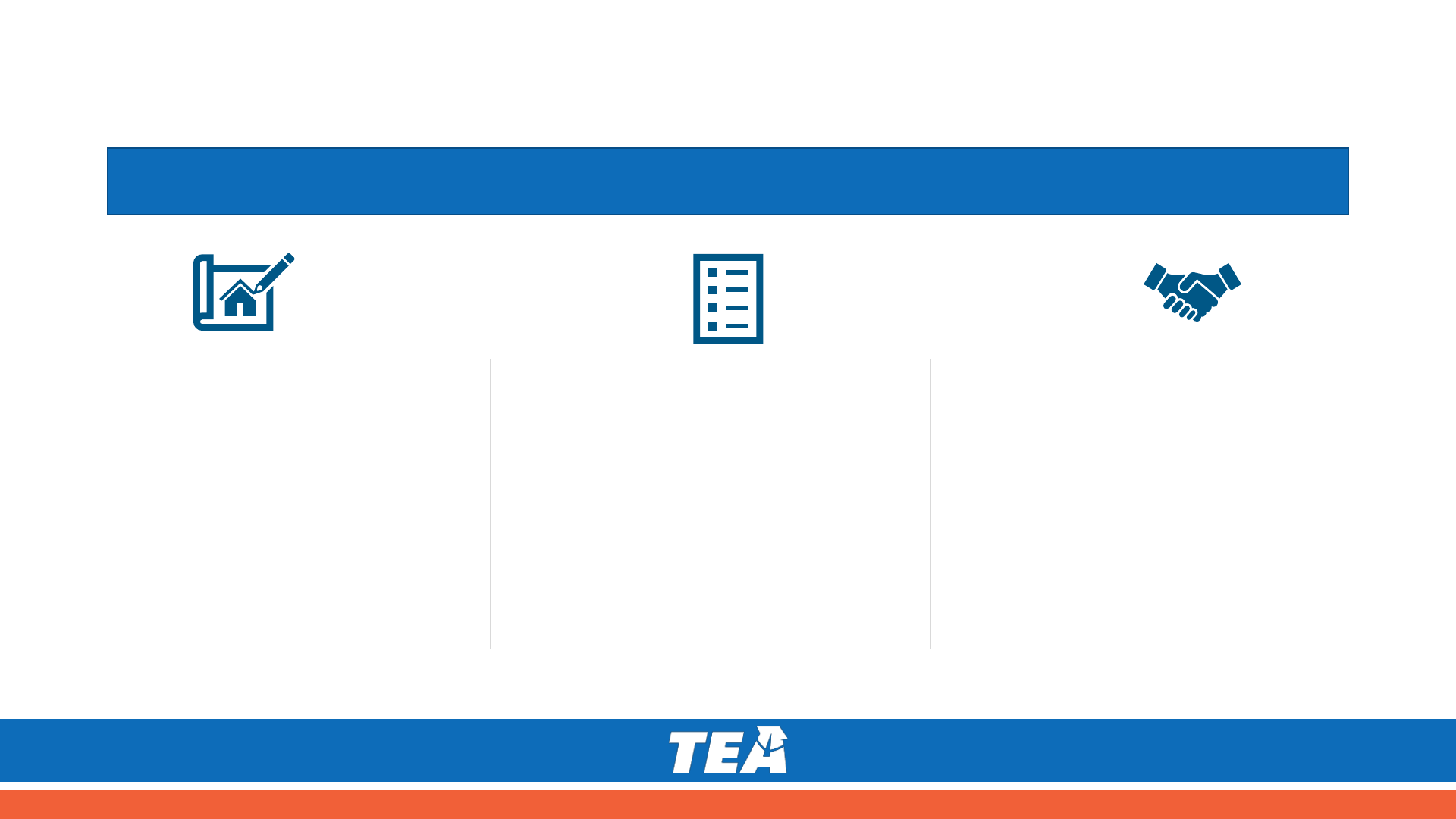
High Impact Tutoring:
Program Implementation
As you join us, please:
Introduce yourself via chat with your name,
LEA/Organization, and your favorite summer activity.

Introduction: TEA Team
A few logistical notes:
• Feel free to enter
questions and reactions
in the chat box
throughout
• We will follow up with the
slides and recording
2
Megha Kansra
Director of System
Support & Innovation
Megha.Kansra
@tea.texas.gov
Lizette Ridgeway
Director of District
Systems and Strategies
Lizette.Ridgeway
@tea.texas.gov
Colby Self
Director of Texas
Tutoring Supports
Colby.Self@tea.texas.
gov

Agenda for Today
3
Quick Recap of High Impact Tutoring
Update on TEA Tutoring Supports
LEA Spotlight: Spring ISD
High Impact Tutoring Toolkit: Program Implementation
Closing and Questions

Key Principles of High Impact Tutoring
4
High impact tutoring programs have a
few key attributes
1
…
…and can have a significant impact on
student outcomes
Well-trained, consistent tutor (can be a teacher,
paraprofessional, teacher candidate) who builds
a strong relationship with students
High quality instructional material aligned to
standards and core classwork
At least three sessions per week for
sustained support, 30 minutes minimum
Data-driven with tutors building sessions around
student strengths and needs
Embedded in the school day or immediately
before or after, to maximize student access
5
months
Additional progress
One-to-one or small group for individualized
support (1-to-3 maximum ratio recommended)
2
A 2020 meta-analysis of 96 studies of
high-quality tutoring programs found
that students made 5 months of
additional progress on average, a large
pooled 0.37 effect size
3
Sources: 1) Kraft, Matthew A., and Grace Falken. (2021). A Blueprint for Scaling Tutoring Across Public Schools. (EdWorkingPaper: 21-335). Annenberg Institute at Brown University: https://doi.org/10.26300/dkjh-s987; 2) Researchers are still vetting the effectiveness of 1:4 groups and currently recommend a careful
approach to 1:4 support, with Dr. Robert Slavin (Johns Hopkins University) recommending: “I would keep careful track of how students are progressing…A lot of kids will be successful at one-to-four [groups] but there may be kids who are not, and I would reserve one-to-one for those who are not” (Source: Education
Week) 3) Nickow, Andre Joshua, Philip Oreopoulos, and Vincent Quan. (2020). The Impressive Effects of Tutoring on PreK-12 Learning: A Systematic Review and Meta-Analysis of the Experimental Evidence. (EdWorkingPaper: 20-267). Annenberg Institute at Brown University: https://doi.org/10.26300/eh0c-pc52; 4)
Kraft, M. A. (2020). Interpreting effect sizes of education interventions. Educational Researcher, 49(4), 241-253.

High Impact Tutoring Webinars
5
Overview
The High Impact Tutoring Webinars are intended to provide LEAs with an overview of high impact tutoring. With the
signing of recent House Bills, TEA will be adding additional webinars to the calendar in the near future.
Overview of
High Impact
Tutoring
Program Design
Program
Implementation
Continued
Support For
Implementation
The recording and slides from the first two webinars
can be found on the Strong Start page
May 7, 11 May 26 June 17 Date TBD

TEA Supports
6

Texas Tutoring Supports
7
High-Impact Tutoring
Implementation
Workshop Series
LEA Supports
Vetted TX Tutor
Corps
4-week Workshop Series for LEA Academics &
Tutoring Leads
• Guidance and support to design and execute
a high impact tutoring program
• Facilitated decision-making &
implementation support
• Development of key implementation tools
(e.g., training material)
Webinar series for interested LEAs sharing:
• Introduction to high impact tutoring and
implementation toolkit
• Decision-making guidance
• Implementation guidance (e.g., effective
tutor training)
• Additional TEA and/or ESC supports
TEA-subsidized tutoring supports
• TEA-subsidized high-quality instructional
materials
• TEA-subsidized tutoring platform for in-
person and virtual tutoring
• Tutors sourced and trained in alignment
with principles of high impact tutoring
• Ongoing support, assessment-driven
quality checks with LEAs
• Continuous tutor training to improve
program
Statewide
Webinars
Continuum of support level options

TEA is Creating Optional Supports to Help School Systems
Implement Supplemental Instruction (Tutoring) Requirements
8
Use Vetted Tutor Provider with
Subsidized Curriculum and Training
(Vetted Texas Tutor Corps)
Resources: Vetted curriculum, tutoring
platform, vetted tutor recruitment
organizations, aligned tutor training by
TEA or ESCs, subsidized costs
Timeline: End of July
Build it Yourself
Resources: Statewide Webinar
Series, High Impact Tutoring
Toolkit, High Impact Tutoring
Workshop Series
Timeline: Available Now,
Additional Workshops Coming in
July
Use Pre-approved List
Resources: Clearinghouse of
pre-approved full and partial
tutor program providers
Timeline: End of June
(rolling deadline)
Three Approaches

High Impact Tutoring Implementation Workshop
Series
9
Date(s)
Event
June 21 – July 16
State
-wide Cohort 1 (application closed)
Beginning in
August
Statewide Cohort 2 and Regional Cohorts
Overview
The High Impact Tutoring Implementation Workshop Series is intended to provide training and coaching to districts to help
them establish high-impact tutoring programs. This training will also serve as a trainer of trainer model to train other
entities such as Education Service Centers to facilitate future workshops.
Timeline
Scope and Sequence
Orientation
Workshop 1: Program Aim
Workshop 2: Identifying Students and Budget Needs
Workshop 3: Hiring and Training Tutors + Materials
Workshop 4: Evaluation and Communication
Host
Amplify is a publisher of K–12 core and
supplemental curriculum, assessment,
and intervention programs for today’s
students.
Build it
Yourself

HB 4545
10
Overview
HB 4545 specifies the requirement for providing accelerated instruction for students who fail to achieve satisfactory
performance on certain assessment instruments.
Each time a student fails to perform
satisfactorily on an assessment instrument in
grades 3 - 8, the school district shall provide
accelerated instruction in the applicable subject
area during the subsequent summer or school
year and either*:
1. Allow the student to be assigned a
classroom teacher who is certified as a
master, exemplary, or recognized teacher
for the subsequent school year in the
applicable subject area; or
2. Provide the student supplemental
instruction (e.g., tutoring)
Supplemental instruction must:
• Include targeted instruction (e.g., grade level and subject area)
• Be provided in addition to instruction normally provided
• Be provided for no less than 30 total hours – if it takes place in the school year
it must occur at least once per week
• Include effective instructional materials designed for supplemental instruction
• Be provided individually or in a group of no more than 3 unless a parent of
each student authorizes a larger group
• Be provided by a person with training in the materials and under the oversight
of the school district
• To the extent possible, be provided by one person for the entirety of the
supplemental instruction period
*If a district receives funding from the Coronavirus Response and Relief Supplemental Appropriations Act, 2021 or the American Rescue Plan Act of 2021.
Source: https://capitol.texas.gov/tlodocs/87R/billtext/pdf/HB04545F.pdf#navpanes=0

HB 4545 (cont.)
11
Overview
HB 4545 specifies the requirement for providing accelerated instruction for students who fail to achieve satisfactory
performance on certain assessment instruments.
Other Information
• Each school district shall establish a process allowing for the parent or guardian to request that the student be assigned to a
particular classroom teacher in the applicable subject area of the subsequent school year, if more than one classroom teacher is
available.
• The educational plan must be documented in writing, and a copy must be provided to the student ’s parent or guardian.
• The board of trustees of each school district shall adopt a policy to allow a parent to contest the content or implementation of an
educational plan.
• If the student fails again, the superintendent shall meet with the accelerated learning committee to identify the reason and
appropriate path forward.
*If a district receives funding from the Coronavirus Response and Relief Supplemental Appropriations Act, 2021 or the American Rescue Plan Act of 2021.
Source: https://capitol.texas.gov/tlodocs/87R/billtext/pdf/HB04545F.pdf#navpanes=0

LEA Spotlight
12

Spring ISD: Integrated Intervention Blocks
14
14

Spring ISD: Overview of 2020-21 Tutoring Program
15
Program Focus
• Small group accelerated high dosage
tutoring in reading, writing, math, and
language development (ELs)
• Students were identified based on Fall
STAAR Interim Assessment
results
• Student Selection for High Dosage Tutoring
▪ Targeted campuses were our 6 redesign schools
▪ Students who were served in Special Education
▪ Students who were English Language Learners
▪ Students with the greatest achievement gaps and
who had multiple-year skill deficits
▪ Students in Grades K-8

Spring ISD: Overview of 2020-21 Tutoring Program
16
Structure
• Integrated into the students
school day
• 45 minutes (Sessions)
• 5 times per week

Spring ISD: Overview of 2020-21 Tutoring Program
17
Tutor Selection Partner
▪ Live high-quality tutors
▪ Tutors available in alignment
with student’s home language
▪ 4:1 Student/teacher ratio
▪ Highly engaging/SEL
integration
▪ Data monitoring (dashboard &
weekly/biweekly data debrief)
▪ Schoology integration
▪ Texas Based Company
▪ True TEKS/STAAR Alignment

Spring ISD: Implementation and Lessons
Learned
18
Data Action Planning & Student Growth

Spring ISD: Implementation and Lessons
Learned
19

Spring ISD: Implementation and Lessons
Learned
20
Data Action Plan and Student Growth

Spring ISD: Implementation and Lessons
Learned
21
Engaging the Stakeholders

Spring ISD: Plans for Next Year
22

High Impact Tutoring Toolkit: Program Implementation
23

Introduction to High Impact Tutoring Toolkit
24
The High Impact Tutoring Toolkit outlines the foundational
principles and key considerations that all LEAs should consider
when implementing a high impact tutoring program.
Table of Contents
➢ Background and Research
➢ Key Principles of High Impact Tutoring
➢ Program Design
▪ Assembling The Team
▪ Selecting A Program Focus
▪ Student Prioritization
➢ Creating the Structure
▪ Scheduling
▪ Dosage
▪ Delivery Mode
➢ Selecting a Tutoring Provider
➢ Identifying High-Quality Instructional Materials
➢ Program Implementation
▪ Training Tutors and Providing Ongoing Support
▪ Curriculum and Instructional Strategy
➢ Engaging Stakeholders
➢ Evaluating the Program
➢ Ensuring Equity

Training Tutors and Providing Ongoing Support
25
Key Principles for Tutor Training
1. All tutors, regardless of their experience
and background, benefit from continued
training
2. The design of the tutoring program will
influence training content
3. Student data should also inform training
content
4. Pre-Service Training should focus on
building knowledge, while in-service
training should hone skills
Best Practices for Ongoing Support
1. Create a culture of open
communication and feedback
2. Support tutors in creating their own
goals
3. Plan for regular observation and
debrief cycles
4. Invest in developing a rubric or fidelity
checklist specific to your model

Instructional Strategy
26
Example Session Structure
1. Session Opening: Relationship Building
2. Data Touchpoint
▪ Assess the student’s current mastery of a relevant skill
3. Framing and Objective
▪ Introduce the session’s topic or focus and clearly state today’s learning objective
4. Mini Lesson & Explicit Model
▪ Explicitly model the step-by-step process that students will use to reach the session’s
learning goal
5. Purposeful Independent Practice
▪ Provide plenty of time for multiple “at-bats”
6. Formative Assessment
▪ Let students demonstrate their progress; an exit ticket is often used

Engaging Stakeholders
27
Internal Communication (District and Campus Levels):
1. Communicate the purpose, mission, and goals of the tutoring program
2. Establish continued communication and collaboration channels
3. Solicit additional input from internal stakeholders
External Communication (Parents and Families):
1. Communicate clear expectations about the purpose and desired goals
2. Be transparent; provide specifics related to the setting, tutor background, and
safety measures put in place
3. Continue to solicit feedback and provide an open channel of communication

Evaluating the Program
28
LEAs seeking to effectively use data in their tutoring program should develop: (1) a performance
measurement plan and (2) regular routines for data review
1. A Performance Measurement Plan
outlines how to assess a program’s
progress and assess whether the
program is on track.
2. Data Review is the process of
collecting data, reflecting on it, and
distilling it into actionable insights.
Regular cycles of Data Review will
ensure that the tutoring program
maintains consistent progress toward
its goals.
Excerpt from an example performance measurement plan

Closing & Questions
29

We’re Here To Help!
30
Please contact us with any questions! We have a dedicated
communication stream to empower and enable success
around high-impact tutoring work.
Email: TexasT[email protected]xas.gov

